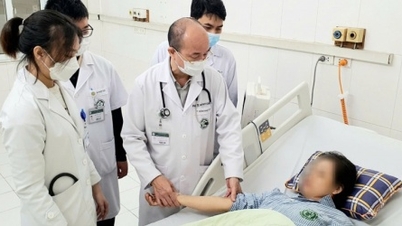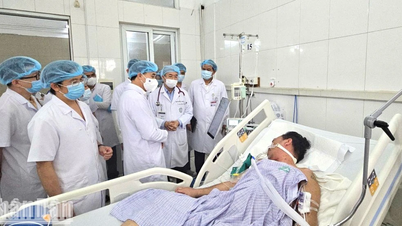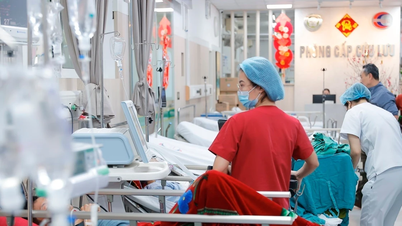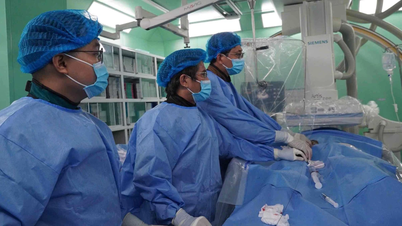According to the National Children's Hospital, in the current changing weather, the hospital's Tropical Disease Center has received and treated many children hospitalized with meningitis.
According to the National Children's Hospital, in the current changing weather, the hospital's Tropical Disease Center has received and treated many children hospitalized with meningitis.
For example, in the case of a boy (7 years old, in Hanoi), with a history of good health. About 1 day before being admitted to the hospital, the child had a headache, accompanied by vomiting and fever.
 |
| Photo caption |
The family took the child to a medical facility for examination. There, doctors suspected that the child had meningitis and the child was transferred to the National Children's Hospital for treatment.
After being admitted to the hospital, doctors quickly conducted clinical examinations and performed diagnostic tests.
The results showed that the child's cerebrospinal fluid contained many white blood cells, mainly lymphocytes, and the PCR test was positive for Enterovirus (EV).
Similarly, a 10-year-old boy from Hanoi was admitted to the hospital after having a fever the day before. In addition to the fever, the child also had severe vomiting, fatigue, headache and a stiff neck.
Realizing that this was a suspected case of meningitis, the doctors admitted the child to the hospital and performed diagnostic tests. The results showed that the child had meningitis caused by EV.
After treatment according to the protocol, the child was discharged from the hospital without complications. Doctor Pham Thi Que, Center for Tropical Diseases, National Children's Hospital said that meningitis occurs in all ages but the risk is higher in people with weakened immune systems and children.
The most common causes of the disease include: Enterovirus (Coxsackie or Echovirus group), Herpesvirus (HSV1 and 2, VZV, CMV, EBV, HHV6), Arbovirus group (Japanese encephalitis virus, dengue virus, ...).
Enterovirus (EV) is a family of intestinal viruses, including many different types of viruses and can cause epidemics. EV is mainly transmitted through the digestive tract, meaning that the patient will excrete the virus in the stool or through oral secretions, thereby infecting surrounding children. In addition to causing meningitis, EV also causes hand, foot and mouth disease.
The main symptoms of viral meningitis in general and Enterovirus in particular can appear suddenly, including fever, chills, headache, stiff neck, nausea or vomiting, sensitivity to light (photophobia), loss of appetite, fatigue.
Sometimes there are symptoms of a viral infection, such as: runny nose, cough, body aches or rash, before symptoms of meningitis appear.
In newborns, symptoms are often nonspecific, including fever, vomiting, bulging fontanelle, poor feeding, excessive sleeping, etc. To make a definitive diagnosis, the child needs to have a lumbar puncture and PCR testing to determine the cause.
According to Dr. Pham Thi Que, there is currently no specific treatment or vaccine for meningitis caused by EV. Therefore, to prevent the disease in children, parents and caregivers need to instruct children to wash their hands with soap before eating, after coughing, sneezing, and using the toilet.
In addition, eat cooked food, boil water, use clean food with clear origin. Clean shared toys, keep the living environment clean, disinfect frequently contacted surfaces such as doorknobs, tables, and chairs to prevent the spread of viruses.
When children show signs of vomiting, headache, and do not respond to fever-reducing medication, they should be taken immediately to the nearest medical facility for timely diagnosis and treatment by a doctor.
According to statistics, children are at higher risk of meningitis than adults with typical symptoms including headache, fever, stiff neck. In addition, children also have some accompanying symptoms such as chills, nausea, poor feeding, anorexia, convulsions, rash, confusion, crying, etc.
Children under 1 year old have the highest and most severe risk of meningitis compared to other age groups, especially children under 5 months old.
In infants and young children, the immune system is not yet fully developed and the concentration of protective antibodies from the mother is reduced, leading to low antibacterial ability, making children more susceptible to disease.
Infants are at higher risk of developing neurological complications than adults. 71% of infants, 38% of children aged 1-5 years, and 10% of children aged 6-16 years with meningitis develop neurological complications.
Meningitis in children can be cured if diagnosed early and treated properly and promptly. Seven out of 10 children with meningitis will recover completely, without complications, if treated properly.
However, the risk of death from meningitis is very high. Nearly 10% of meningitis cases die within 24-48 hours of the first signs of the disease. The remaining 20%, although cured, may still face many serious sequelae such as deafness, mental retardation, blindness, memory loss, amputation, etc.
Impact of meningitis: People with meningococcal disease can die within 24-48 hours of the onset of the disease. 50% die if not treated. On the other hand, even with timely diagnosis and treatment, about 20% of patients still die.
Of those who survive, 10-20% experience serious complications such as amputation, deafness, brain damage, and learning disabilities.
It is estimated that the cost of treatment and long-term monitoring of a case of meningitis ranges from hundreds of millions to billions of dong, not to mention the costs of nurturing and caring for people with serious health consequences later on.
Therefore, infection and treatment are many times more difficult and expensive than early prevention with vaccines. Children and adults now have many effective vaccines to prevent meningitis caused by many agents such as viruses and bacteria.
Source: https://baodautu.vn/canh-giac-voi-benh-viem-mang-nao-do-virus-o-tre-d228177.html




![[Photo] Prime Minister Pham Minh Chinh works with the Standing Committee of Thai Binh Provincial Party Committee](https://vphoto.vietnam.vn/thumb/1200x675/vietnam/resource/IMAGE/2025/5/12/f514ab990c544e05a446f77bba59c7d1)

![[Photo] Prime Minister Pham Minh Chinh receives Swedish Minister of International Development Cooperation and Foreign Trade](https://vphoto.vietnam.vn/thumb/1200x675/vietnam/resource/IMAGE/2025/5/12/ae50d0bb57584fd1bbe1cd77d9ad6d97)
![[Photo] Prime Minister Pham Minh Chinh starts construction of vital highway through Thai Binh and Nam Dinh](https://vphoto.vietnam.vn/thumb/1200x675/vietnam/resource/IMAGE/2025/5/12/52d98584ccea4c8dbf7c7f7484433af5)





















































































Comment (0)